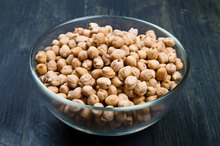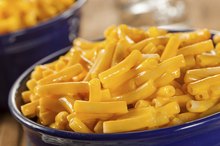Kikkoman Soy Sauce Ingredients
Soy sauce, a common condiment throughout Asia, is a fermented sauce with a salty taste which is aged for several months. Kikkoman says its soy sauce consists of five flavors: sweet, sour, salty, bitter and umami -- a flavor created when soybean and wheat, two ingredients in the sauce, are broken down into different proteins. The website claims their soy sauce contains only four ingredients: soybeans, wheat, salt and water. A fifth ingredient, aspergillis, a type of fungus, is added to produce Koji mold, which activates the fermentation that creates the soy sauce.
Nutrition
Soy sauce contains only 10 calories per tbsp. According to LIVESTRONG.com MyPlate, 2 g come from protein. Since protein contains 4 calories per g, a 1 tbsp. serving supplies eight calories from protein, most of which comes from the soybean. This equals 4 percent of your daily protein requirement based on a 2,000-calorie-per-day intake. Carbohydrate and fat amounts are listed as zero, the sauce could only contain minute amounts of both.
- Soy sauce contains only 10 calories per tbsp.
- Carbohydrate and fat amounts are listed as zero, the sauce could only contain minute amounts of both.
Soybeans
Symptoms of Allergies to Chickpeas and Soy
Learn More
Soybeans are legumes that contain isoflavones -- substances that have effects similar to estrogen, the dominant female hormone. Soybeans are also good sources of protein. When eaten in larger quantities as part of a meal, soybeans may help lower cholesterol levels. However, the number of soybeans used to make a single serving of soy sauce is small.
- Soybeans are legumes that contain isoflavones -- substances that have effects similar to estrogen, the dominant female hormone.
- When eaten in larger quantities as part of a meal, soybeans may help lower cholesterol levels.
Wheat
Soy sauce contains a small amount of wheat, which is roasted and then crushed to help the fermentation process. People who are allergic to wheat or who have a gluten intolerance should avoid soy sauce. Kikkoman recently began producing a soy sauce for those allergic to wheat. It is made with rice.
- Soy sauce contains a small amount of wheat, which is roasted and then crushed to help the fermentation process.
- People who are allergic to wheat or who have a gluten intolerance should avoid soy sauce.
Sodium
Side Effects of Zymex
Learn More
Kikkoman soy sauce contains a large amount of sodium per serving -- 920 mg, or 38 percent your maximum daily sodium intake of 2,400 mg. The Mayo Clinic suggests keeping sodium intake to 1,500 mg, especially if you have high blood pressure, kidney disease or diabetes. Sodium can increase blood pressure, which can damage blood vessels and increase the risk of developing heart disease. The Mayo Clinic recommends avoiding any foods that contain more than 200 mg of sodium per serving. Because the sodium count of soy sauce is so high, use it sparingly and occasionally rather than as a regular condiment, and don’t use it at all if you have any risk factors.
- Kikkoman soy sauce contains a large amount of sodium per serving -- 920 mg, or 38 percent your maximum daily sodium intake of 2,400 mg.
- The Mayo Clinic suggests keeping sodium intake to 1,500 mg, especially if you have high blood pressure, kidney disease or diabetes.
Related Articles
References
- Food.com: Soy Sauce
- Mayo Clinic: Sodium: How to Tame Your Salt Habit Now
- Celiac-Disease: Kikkoman Introduces Gluten-Free Soy Sauce
- Soy sauce. FoodData Central. U.S. Department of Agriculture. Published April 1, 2020.
- Blair RM, Henley EC, Tabor A. Soy foods have low glycemic and insulin response indices in normal weight subjects. Nutr J. 2006;5:35. Published 2006 Dec 27. doi:10.1186/1475-2891-5-35
- Rizzo G, Baroni L. Soy, soy foods and their role in vegetarian diets. Nutrients. 2018;10(1):43. Published 2018 Jan 5. doi:10.3390/nu10010043
- Wang H, Jenner AM, Lee CY, et al. The identification of antioxidants in dark soy sauce. Free Radic Res. 2007;41(4):479-88. doi:10.1080/10715760601110871
- Yang, B., Prasad, K. N., Xie, H., Lin, S., & Jiang, Y. Structural characteristics of oligosaccharides from soy sauce lees and their potential prebiotic effect on lactic acid bacteria. Food Chemistry. (2011). 126(2), 590–594. doi:10.1016/j.foodchem.2010.11.048
- Soy Allergy. American College of Allergy, Asthma, and Immunology. Updated April 9, 2019
- Shaking the Salt Habit to Lower High Blood Pressure. American Heart Association. Oct 31, 2016
- Questions and Answers on Monosodium Glutamate (MSG). U.S. Food and Drug Administration. November 19, 2012
- Soy Sauce. USDA FoodKeeper App. Updated April 26, 2019
Writer Bio
A registered nurse with more than 25 years of experience in oncology, labor/delivery, neonatal intensive care, infertility and ophthalmology, Sharon Perkins has also coauthored and edited numerous health books for the Wiley "Dummies" series. Perkins also has extensive experience working in home health with medically fragile pediatric patients.









